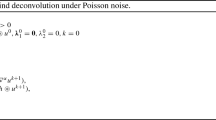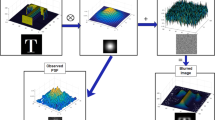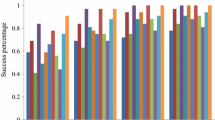Abstract
Image production tools do not always create a clear image, noisy and blurry images are sometimes created. Among these cases, Poissonian noise is one of the most famous noises that appear in medical images and images taken in astronomy. In recent years, various methods have been proposed to improve the quality of the image that has been lost due to this noise. For example, we can refer to methods that use fractional-order and second-order total variation priors or proximal thresholding. In this paper, in the first step, based on framelet transform, a local minimal prior is introduced, and in the next step, this tool together with fractional calculation is used for Poissonian blurred image deconvolution. The framelet transform domain of images usually have sparse representations. It is also well known that the use of framelet transfer has a proper effect on the edges of the restored image. Also, In this study, both blind and nonblind problems are considered. To evaluate the performance of the presented model, several images such as real images have been investigated. Various tools are used to study the efficiency of the proposed method such as PSNR and SSIM. The proposed method is compared with the existing methods such as fractional - order and second-order total variation. The simulation results show the appropriate representation of the proposed method in solving this type of problem.

















Similar content being viewed by others
Data availability statement
Data sharing not applicable to this article as no datasets were generated or analysed during the current study.
References
Naga Srinivasu P, Balas VE, Md Norwawi N (2021) Performance measurement of various hybridized kernels for noise normalization and enhancement in high-resolution MR images. Bio-inspired Neurocomputing 903:1–24
Zhang F, Wei L, Hongmei L, Fei X (2018) Natural image deblurring based on l0-regularization and kernel shape optimization. Multimedia Tools Appl 77(20):26239–26257
Ma C, Zhang J, Xu S, Meng W, Xi R, Kumar GH, Zhang X (2018) Accurate blind deblurring using salientpatch-based prior for large-size images. Multimedia Tools Appl 77(21):28077–28100
Qi Q, Guo J, Li C, Xiao L (2021) Blind face images deblurring with enhancement. Multimedia Tools Appl 80(2):2975–2995
Javaran TA, Hassanpour H, Abolghasemi V (2019) Blind motion image deblurring using an effective blur kernel prior. Multimedia Tools Appl 78:22555–22574
De Bruijne M, Cattin, PC, Cotin S, Padoy N, Speidel S, Zheng Y, Essert C (eds) (2021) Medical image computing and computer assisted intervention-MICCAI 2021. In: 24th International conference, Strasbourg, 2021, vol 12903. Springer
Gendler R (2013) Lessons from the masters. In: Lessons from the masters: current concepts in astronomical image processing (the patrick moore practical astronomy series), vol 179. Springer, New York
Madhura J, Babu DRR (2017) A survey on noise reduction techniques for lung cancer detection. In: 2017 International conference on innovative mechanisms for industry applications (ICIMIA), pp 637–640
Thanh D, Prasath S (2019) A review on CT and X-ray images denoising methods. Informatica 43(2)
Sikula J, Levinshtein M, and Levinshtein ME (eds) (2004) Advanced experimental methods for noise research in nanoscale electronic devices, vol 151. Springer
Rudin LI, Osher S, Fatemi E (1992) Nonlinear total variation based noise removal algorithms. Physica D Nonlin Phenom 60(1–4):259–268
Chen G, Li G, Liu Y, Zhang XP, Zhang L (2019) SAR image despeckling based on combination of fractional-order total variation and nonlocal low rank regularization. IEEE Trans Geosci Remote Sens 58(3):2056–2070
Ren Z, He C, Zhang Q (2013) Fractional order total variation regularization for image super-resolution. Signal Process 93(9):2408–2421
Han B (2017) Framelets and wavelets. Algorithms, analysis, and applications. In: Applied and Numerical Harmonic Analysis. Birkhäuser, Cham
Parvaz R (2022) Point spread function estimation for blind image deblurring problems based on framelet transform. Vis Comput 39:1–17
Liu J, Lou Y, Ni G, Zeng T (2020) An image sharpening operator combined with Framelet for image deblurring. Inverse Probl 36(4):045015
Chen Y, Huang Y, Wang L, Huang H, Song J, Yu C, Xu Y (2022) Salt and pepper noise removal method based on stationary Framelet transform with non-convex sparsity regularization. IET Image Process 16(7):1846–1865
Huang J, Huang TZ (2019) A nonstationary accelerating alternating direction method for frame-based Poissonian image deblurring. J Comput Appl Math 352:181–193
Feng Y, Shi Y, Sun D (2020) Blind Poissonian image deblurring regularized by a denoiser constraint and deep image prior. Math Probl Eng 2020
Shi Y, Song J, Hua X (2017) Poissonian image deblurring method by non-local total variation and framelet regularization constraint. Comput Electr Eng 62:319–329
He K, Sun J, Tang X (2010) Single image haze removal using dark channel prior. IEEE Trans Pattern Anal Mach Intell 33(12):2341–2353
Pan J, Sun D, Pfister H, Yang MH (2016) Blind image deblurring using dark channel prior. In: Proceedings of the IEEE conference on computer vision and pattern recognition, pp 1628–1636
Wen F, Ying R, Liu Y, Liu P, Truong TK (2020) A simple local minimal intensity prior and an improved algorithm for blind image deblurring. IEEE Trans Circuits Syst Video Technol 31(8):2923–2937
Liu J, Tan J, Zhang L, Zhu X, Ge X (2022) Blind image deblurring via L 1-regularized second-order gradient prior. Multimedia Tools Appl 81(27):39121–39144
Chowdhury MR, Qin J, Lou Y (2020) Non-blind and blind deconvolution under poisson noise using fractional-order total variation. J Math Imag Vis 62(9):1238–1255
Liu R, Jia J (2008) Reducing boundary artifacts in image deconvolution. In: 2008 15th IEEE international conference on image processing, pp 505-508
Averbuch AZ, Neittaanmäki P, Zheludev VA (2014) Spline and spline wavelet methods with applications to signal and image processing, vol 1. Springer, New York
Shukla AK, Pandey RK, Reddy PK (2020) Generalized fractional derivative based adaptive algorithm for image denoising. Multimedia Tools Appl 79(19):14201–14224
Guo Z, Yao W, Sun J, Wu B (2019) Nonlinear fractional diffusion model for deblurring images with textures. Inverse Probl Imag 13(6):1161
Yang XJ (2019) General fractional derivatives: theory, methods and applications. Chapman and Hall/CRC, Boca Raton
Cafagna D (2007) Fractional calculus: a mathematical tool from the past for present engineers [past and present]. IEEE Ind Electron Mag 1(2):35–40
Gabay D, Mercier B (1976) A dual algorithm for the solution of nonlinear variational problems via finite element approximation. Comput Math Appl 2(1):17–40
Glowinski R, Americo M (1975) Sur l’approximation, par éléments finis d’ordre un, et la résolution, par pénalisation-dualité d’une classe de problèmes de Dirichlet non linéaires. ESAIM Math Model Numer Anal Modél Math Anal Numér 9(R2):41–76
Eckstein J, Bertsekas DP (1992) On the Douglas-Rachford splitting method and the proximal point algorithm for maximal monotone operators. Math Program 55(1):293–318
Dey N, Blanc-Feraud L, Zimmer C, Roux P, Kam Z, Olivo-Marin JC, Zerubia J (2006) Richardson-Lucy algorithm with total variation regularization for 3D confocal microscope deconvolution. Microsc Res Techn 69(4):260–266
Levin A, Weiss Y, Durand F, Freeman WT (2009) Understanding and evaluating blind deconvolution algorithms. In: 2009 IEEE conference on computer vision and pattern recognition, pp 1964–1971
Wen YW, Chan RH (2011) Parameter selection for total-variation-based image restoration using discrepancy principle. IEEE Trans Image Process 21(4):1770–1781
Langer A (2017) Automated parameter selection for total variation minimization in image restoration. J Math Imag Vis 57:239–268
Dupé FX, Fadili MJ, Starck JL (2008) Image deconvolution under Poisson noise using sparse representations and proximal thresholding iteration. In: 2008 IEEE international conference on acoustics, speech and signal processing, pp 761–764
Landi G, Piccolomini EL (2012) An efficient method for nonnegatively constrained Total Variation-based denoising of medical images corrupted by Poisson noise. Comput Med Imag Graph 36(1):38–46
Azzari L, Foi A (2017) Variance stabilization in Poisson image deblurring. In: 2017 IEEE 14th international symposium on biomedical imaging (ISBI 2017), pp 728-731
Jon K, Liu J, Lv X, Zhu W (2021) Poisson noisy image restoration via overlapping group sparse and nonconvex second-order total variation priors. PLoS One 16(4):e0250260
Acknowledgements
We would like to thank the reviewers for their helpful comments and suggestions which greatly improve the quality of the paper. We also thank Dr. Yu Shi for providing some codes.
Author information
Authors and Affiliations
Corresponding author
Ethics declarations
Declaration of Interest Statement
The authors declare that they have no known competing financial interests or personal relationships that could have appeared to influence the work reported in this paper.
Additional information
Publisher's Note
Springer Nature remains neutral with regard to jurisdictional claims in published maps and institutional affiliations.
Rights and permissions
Springer Nature or its licensor (e.g. a society or other partner) holds exclusive rights to this article under a publishing agreement with the author(s) or other rightsholder(s); author self-archiving of the accepted manuscript version of this article is solely governed by the terms of such publishing agreement and applicable law.
About this article
Cite this article
Parvaz, R. Poissonian blurred image deconvolution by framelet-based local minimal prior. Multimed Tools Appl (2023). https://doi.org/10.1007/s11042-023-17733-4
Received:
Revised:
Accepted:
Published:
DOI: https://doi.org/10.1007/s11042-023-17733-4




